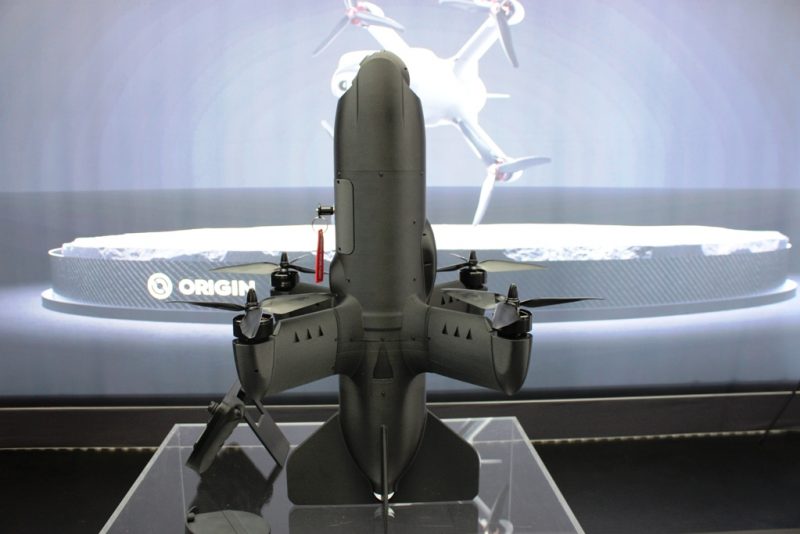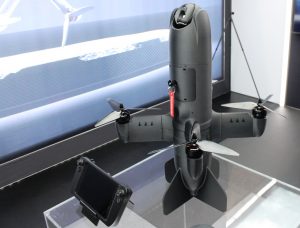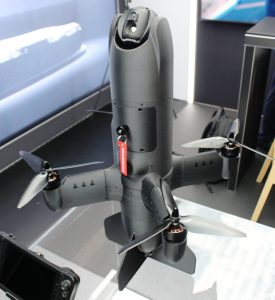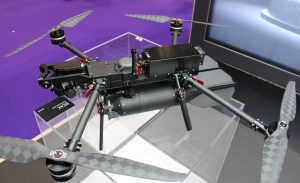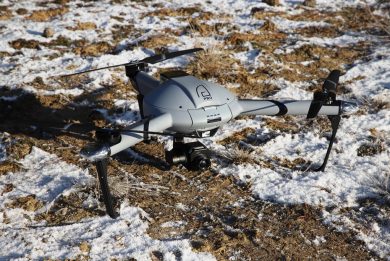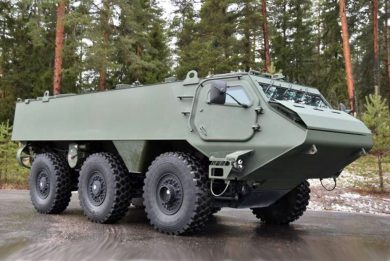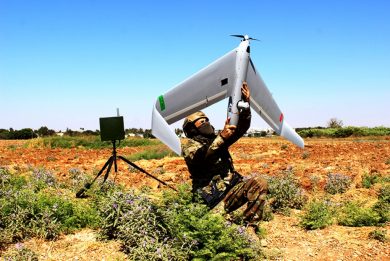DSEI 2025 – Origin Robotics counter-UAS interceptor Blaze
Origin Robotics, a Latvia-based drone manufacturer, showcased its Blaze counter-UAS interceptor at DSEI UK 2025, following the system’s launch in May
The man-portable drone weighs under 6 kg and carries an 800-gram high-explosive fragmentation warhead, a figure confirmed by Raitis Kipurs, the company’s Business Development & Marketing Manager. According to Origin Robotics, Blaze can be readied for launch in under 10 minutes and engage targets at ranges beyond 10 km. Blaze takes off vertically; it has a near-cylindrical fuselage with four tail wings at the rear, which allow it to stand up before launch. Four wings are also set at 90° from each other and carry, at their extremities, pods containing electric motors, which activate three-blade propellers. The four propellers allow lift-off, after which the airframe rotates and begins flying horizontally, with the propellers providing the thrust that enables aerodynamic lift. At the front, we find the optronic suite, followed by the warhead.
At the London exhibition, Agris Kipurs, co-founder and CEO of Origin Robotics, discussed how Blaze’s RF jamming-resistant technology ensures a consistent and stable uplink between the operator and the system. By providing the stable uplink, the operator maintains ‘wave-off capabilities’ which guarantee that the operator retains control and override capabilities if required. Blaze is equipped with a three-level safety system, which ensures the controlled arming of the interceptor and prevents unintended detonation. Additionally, the system contains a self-destruct protocol that is triggered if the interceptor’s geofence is breached or should a system failure or loss of communication occur. According to Kipurs, Blaze is fitted with a “STANAG-compliant electronic safe and arm device”, providing the necessary assurances required for NATO use.
The interceptor utilises a combination of radar-based detection and artificial intelligence-driven computer vision for targeting, and is equipped with both electro-optical and infrared sensors. Blaze utilises the command-and-control system’s radar for radar-guided navigation during its initial approach to the target. Once within a certain proximity, the system combines its sensors and AI-enabled recognition for target identification and lock-on. Following this, the operator is required to confirm engagement of the target. At this point, the system will initiate engagement along the most optimal route, providing the highest probability of interception. Once within a certain proximity to the target, the interceptor will detonate the 800-gram HE fragmentation warhead, neutralising the threat. This can be done in either a kinetic or an airburst manner, depending on the situation.
Blaze can be easily integrated into an existing air defence architecture. With its range exceeding 10km, it is positioned to intercept targets as a primary layer of defence, according to Kipurs. The system is a one-target-to-one-interceptor solution, but with its MESH radio capability, the end user can coordinate multiple interceptors simultaneously to counter multiple threats.
Origin Robotics is also responsible for the development of the Beak, a man-portable drone-launched precision-guided weapon system. The Beak is a conventional VTOL quadcopter, with an upper spar carrying electronics, batteries and the optronic package at the front, and lethal payloads attached underneath. Four spars, each carrying an electric motor activating a two-blade rotor/propeller, are connected to the body.
The UAV is fitted with an optronic gimbal with 3-axis stabilisation, capable of rotating 360°. It hosts three main sensors: an HD day camera with an 8x optical zoom, a 4K spotter camera with a long telephoto lens, and a thermal camera with a 640×512 array equipped with a 19 mm F/1.0 long-range lens, with a laser pointer being offered as an option. It carries a 4 kg maximum payload, which can be comprised of 2, 4, or 6 munitions held by a release mechanism that can be rapidly attached to the drone. The drone can also carry several types of munitions, as requested by customers. In the ISR configuration, with a 7.2 kg take-off mass, the Beak has a 60-minute endurance. In the attack configuration, at 11.2 kg, this is reduced to 35 minutes.
Three NATO countries, including Latvia, currently use Beak; additionally, it is operationally deployed in Ukraine. Kipurs confirmed that the list of NATO countries using the Beak systems would increase by the end of 2025, in addition to several countries being expected to acquire the Blaze system.
Kipurs emphasised that both Beak and Blaze were built to deliver reliable performance without falling into the trap of over-engineering, a design philosophy that keeps the systems affordable and practical for rapid adoption. Together, they provide complementary capabilities: Blaze as a counter-UAS interceptor and Beak as a drone-launched ISR and precision-strike platform.
As uncrewed aerial systems become more affordable and accessible, the threat they pose to militaries and critical infrastructure will only increase. Effective countermeasures must therefore be not just technically capable, but also cost-effective and adaptable for widespread use. Origin Robotics’ systems are intended to address this demand, but whether acquisition processes will recognise emerging suppliers over established suppliers remains uncertain.
Photos by A. Haywood

